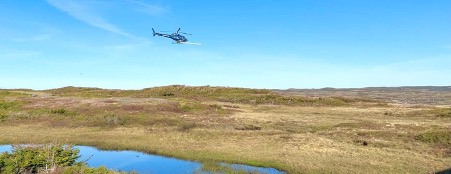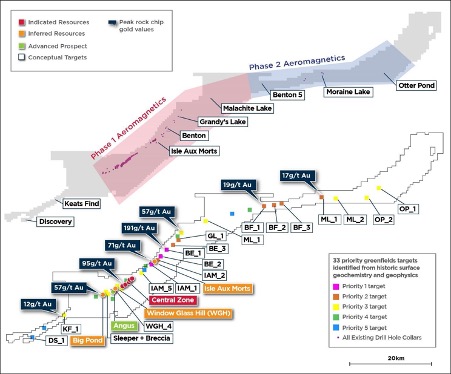Matador secures another huge chunk of prospective ground in Newfoundland on back of airborne survey

Pic: Bloomberg Creative / Bloomberg Creative Photos via Getty Images
Matador Mining (ASX: MZZ) has staked another 320km2 of prospective exploration tenure in Canada’s rising Newfoundland gold district on the back of a major airborne magnetic survey.
The pegging spree will give Matador access to five new prospective zones on top of the myriad of high quality targets already on offer at Cape Ray, where a 20,000m diamond drilling campaign is under way.
That has come from a review of only preliminary magnetic data, which mapped the geology of Cape Ray “in unprecedented detail”, with a full suite of results set to be processed and delivered in the September Quarter.
That Cape Ray has potential to deliver further is good news for the gold explorer, especially since its mineral resource of 840,000oz at an average grade of 2.6g/t gives it a grade base to work off.
All up 16.500 line kilometres were flown in the survey, targeting magnetic structures that provide indications of gold mineralisation under the surface.
It traced the geology over 40km of strike between the Big Pond deposit in the south-west to the Benton Five prospect in the north-east.
Early results will add weight to the junior’s conviction that Cape Ray remains substantially underexplored.

The company’s geologists are especially bullish about the outcomes, with exploration manager Warren Potma lauding a “step-change” in structural targeting at Cape Ray.
“Where these rock units are cut by faults, shear zones and other structures known to concentrate gold across the project, the structures are highly visible in the magnetic maps,” he said.
“The known deposits at Central Zone, Isle aux Morts, Big Pond and Window Glass Hill are all related to key shear zones, cross faults and granite intrusions that are clearly visible in the new detailed magnetics.
“It is now evident from these new data that this structural complexity, a key ingredient in world-class orogenic gold systems, persists throughout the length of Matador’s Cape Ray Gold Project area.
“These structures were effectively invisible in the less detailed historical magnetics data. This new ultra-detailed heli-mag dataset will facilitate a step-change in structural targeting for Matador and has already resulted in Matador staking new ground adjacent to our existing Cape Ray Gold Project tenements”.

Matador building nicely at Cape Ray
It is not the first time Matador has added new ground to its extensive Newfoundland package.
It banked the new Hermitage Project to the east of Cape Ray earlier this month on the back of exploration successes elsewhere in the district, in particular at TSX-Listed New Found Gold’s Queensway project.
Cape Ray is more advanced than some other projects in the emerging district, with Matador already completing a scoping study last year based around the existing resource.
That study estimated the mine would produce 483,000oz of gold over a seven-year life at low all-in-sustaining-costs of just $US776/oz, well under half the current gold price, with a payback period of 1.75 years.
That obviously came ahead of the current drilling blitz Matador is unleashing on a string of targets within 15km of the known resource.
This article was developed in collaboration with Matador Mining, a Stockhead advertiser at the time of publishing.
This article does not constitute financial product advice. You should consider obtaining independent advice before making any financial decisions.
Related Topics

UNLOCK INSIGHTS
Discover the untold stories of emerging ASX stocks.
Daily news and expert analysis, it's free to subscribe.
By proceeding, you confirm you understand that we handle personal information in accordance with our Privacy Policy.








